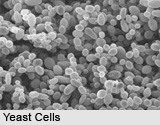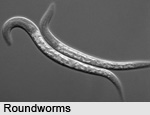
Basic research using model organisms has taught us much of what we know about what it means to be alive. This research has identified the fundamental properties of how cells grow and divide, how inheritance works, and how organisms store and use energy. With model organisms, scientists continue to learn more about how the brain works and about what drives behaviors like eating, sleeping, sex, and even aggression. This foundation of knowledge has led to new methods for maintaining health and for diagnosing and treating disease.
 What is a model?
What is a model?
The word model has many meanings, but in science, a model is a simplified system that is accessible and easily manipulated. A model organism is an animal, plant, or microbe that can be used to study certain biological processes.
Why use model organisms?
Research on bacteria, yeast, insects, worms, rodents, and even plants has shown that the basic operating principles are nearly the same in all living things. So a finding made in fruit flies can shed light on a biological process in people.
Model organisms grow quickly, are relatively simple and inexpensive to work with, and are widely available for use in experiments.
Why is model organism research useful for studying diseases?
 In order to improve our ability to treat and prevent illness, we need to understand human biology much better. In addition, the natural course of a disease in a human may take dozens of years. Simple organisms that can mimic a disease make it possible for a researcher to learn about the disease faster--in a period of months to a few years. That would be nearly impossible, and often unethical, to do in humans.
In order to improve our ability to treat and prevent illness, we need to understand human biology much better. In addition, the natural course of a disease in a human may take dozens of years. Simple organisms that can mimic a disease make it possible for a researcher to learn about the disease faster--in a period of months to a few years. That would be nearly impossible, and often unethical, to do in humans.
When scientists discover that a particular gene is associated with a disease in humans, one of the first things they typically do is find out what that gene does in a model organism. This often provides important clues for understanding the cause of a disease and for developing potential treatments.
How has model organism research impacted human health?
 Yeast studies sorted out the orderly sequence of events, called the cell cycle, in which a cell duplicates its contents and divides into two. This information has benefited millions of people, since many drugs used to treat cancer act by interfering with the cell cycle.
Yeast studies sorted out the orderly sequence of events, called the cell cycle, in which a cell duplicates its contents and divides into two. This information has benefited millions of people, since many drugs used to treat cancer act by interfering with the cell cycle.
- Experiments performed with yeast have also clarified how genes are turned on or off. This knowledge explains how cells that contain the same genes can be so different from one another, which has advanced understanding of both normal developmental processes and diseases that occur when gene activity malfunctions.
- Studies in fruit flies and tiny worms taught scientists key aspects of how fertilized eggs develop into complex organisms. In the course of these studies, researchers made unanticipated discoveries, such as learning that genetically controlled cell death plays a critical role in cancer and other diseases.
 Research with bacteria, viruses, and yeast has revealed how all living things pass on their genes to offspring, through copying DNA and fixing mistakes that get made during this vital activity.
Research with bacteria, viruses, and yeast has revealed how all living things pass on their genes to offspring, through copying DNA and fixing mistakes that get made during this vital activity.
- Laboratory rats have been used for many decades to test drugs. In addition, much of what we know about cancer-causing molecules was learned through basic research with rats.
- Mice can be genetically engineered to serve as models of Lou Gehrig’s disease and many other human illnesses.
- Insects such as fruit flies and honeybees are important models for learning how genes and the environment interact to affect behavior.
- Studies with fruit flies, bread mold, and mice have defined the basic rules of biological clocks, or circadian rhythms, which govern sleep and many important body functions.
 Research in worms has yielded important information about aging. This research is very difficult to do in people and other organisms that have long life spans.
Research in worms has yielded important information about aging. This research is very difficult to do in people and other organisms that have long life spans.
- Model organism research has produced many powerful tools used by scientists all over the world. Examples include RNA interference, DNA chips, and genome-wide scanning methods. These tools are now being used in human health studies.
What more can model organism research tell us?
Scientists still do not have a good understanding of biological complexity, in which many molecular networks operate in synchrony inside our bodies. Researchers are currently mapping these networks in bacteria and yeast, and those studies will be instructive for creating working models of how cells, organs, and tissues function in people.
Model organisms will also be especially useful for clarifying medical problems that have similar molecular causes. For example, protein clumping defects are common to several neurological disorders such as Alzheimer’s, Parkinson’s, and Huntington’s diseases. Scientists can recreate these cellular defects in yeast, worms, and fruit flies, and then the findings can be translated into knowledge to benefit people with those diseases.
 What about computer models?
What about computer models?
Computers serve as virtual laboratories where scientists can do experiments that are very difficult to do in real life. For example, in computer-simulated environments, researchers can introduce into a virtual population a virus with certain characteristics and then watch it spread.
Because the models are so complex, high-performance computers are needed to generate many computer simulations. Often, these computers run for weeks at a time, generating millions of different possible outcomes.
No single set of results or single model can predict exactly what will happen, so researchers often ask the same questions in different kinds of models. When different models yield similar results, scientists have more confidence in the predictions.
Can computer models replace animal models in research?
Even though computer models are limited by what is already known about a process or disease, they are valuable tools that scientists can use to suggest ideas that then can be tested in real organisms. The information that results from the experiments continually enhances the computer modeling approaches. Thus, the two types of models go hand in hand, relying on each other to advance our understanding of health.
Want to learn more about model organism research?
Visit http://www.nigms.nih.gov/Initiatives/Models/
Content created April 2007; reviewed July 2008
